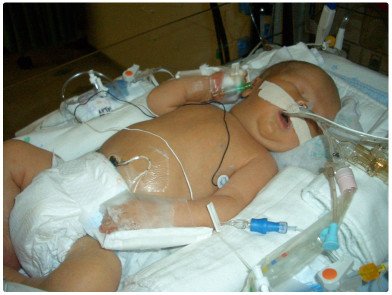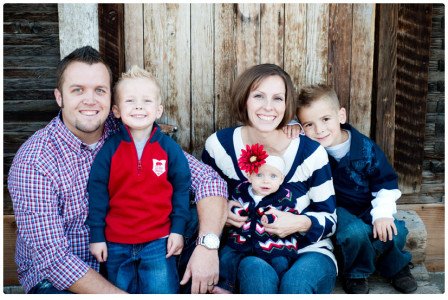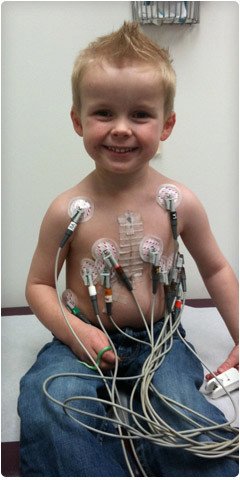 by Melissa Willden
by Melissa Willden
Stansbury Park, Utah
When we found out we were having another little boy joining our family, we were thrilled. We already had a 2-year-old boy at home. Our 20- week ultrasound showed a healthy baby with no problems. He was due the day after Christmas in 2005, so we decided to be induced a week early so that we could be home by Christmas. We chose to have him at LDS Hospital where I was a nurse in the Neonatal Intensive Care Unit (NICU) - I am now a NICU nurse at Intermountain Medical Center.
Everything with the delivery went smoothly. About 2 hours after he was born, I noticed that he looked more pale than normal. I notified my postpartum nurse, and she took him down to the nursery to check him out. After what seemed like forever, she came back to tell me he was in the NICU. Still not feeling too alarmed, I called down to the NICU to see what was going on. The clerk said they were too busy getting him stabilized to come to the phone and were ordering a stat echocardiogram. Knowing what that meant, I was terrified. I asked to be helped into a wheelchair to go and see what was going on.
When I got to the NICU, it was such a strange feeling to see my friends and fellow co-workers caring for my sweet baby. I couldn’t imagine anyone better than my friends and co-workers to care for him. The nurse practitioner told me that he had a serious heart defect that they believed was Ebstein’s Anomaly. They needed my consent to transport him to Primary Children’s Medical Center. What a shock that was! I didn’t believe them at first and kept asking if they were really sure that he had something wrong with his heart.
Within an hour or so, Life Flight’s transport team picked him up and whisked him away from me. His dad got to ride with him, but I had to stay. It was so hard to say goodbye to my new baby that I had just barely met. Once he got to Primary Children’s, they put him on a ventilator and put central lines in him. I woke up about every hour during that first night away from him thinking that I was just having a nightmare. My OB allowed me to be discharged early the next day to go be with him. They took him to the cath lab that day to balloon his pulmonary valve in hopes that it might fix some of the problems he was having. He developed some serious arrhythmias and his heart had to be shocked back into rhythm.
The next few days were very scary, and we weren’t sure if he would make it. His kidneys weren’t working, and he had gained 3 lbs of fluid in his little 6 lb body. They determined that he did not have Ebstein’s, but that it was very similar. He had a severely dysplastic tricuspid valve and pulmonary stenosis. He would eventually need surgery to fix or replace the valves.
At 2 am on Christmas morning, we received a phone call that they could not stabilize his heart rhythm after stopping and restarting his heart with medication, and then shocking it 4 times. They suggested we come back to the hospital prepared to say our goodbyes. We covered up Santa’s gifts under the tree with a blanket and somberly headed to the hospital. After a half hour drive that seemed like an eternity, we got to the NICU not knowing if he would be alive when we got there. Fortunately, they had started a medication that helped his heart rhythm stabilize. Little by little over the next few weeks, he slowly began to recover.
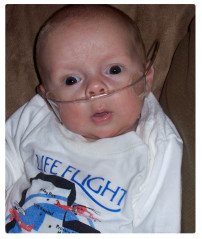 After 24 days in the NICU, he was able to go home. They sent him home on oxygen, which he used for 9 months, monitors, and medications.
After 24 days in the NICU, he was able to go home. They sent him home on oxygen, which he used for 9 months, monitors, and medications.
Over the next few months, we hardly left the house at all. The doctors told us that a cold or virus could put him into heart failure. Over the next 4 years, he had regular echocardiograms, EKG’s and cardiology visits about every 6 months. Not long after his 4th birthday, his doctors decided it was time for his first open heart surgery. They wanted to try and repair his tricuspid valve.
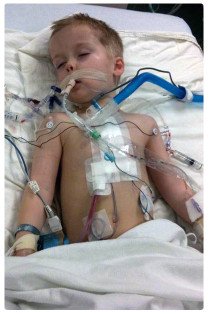 While talking to him and preparing him for surgery, he asked us if after surgery, his heart would “glow in the dark like Iron Man’s?” His nickname then became “Our Little Ironman.” Kissing him goodbye and sending him back with the anesthesiologist for surgery was one of the hardest things we have ever done. His surgeons felt like his surgery was successful, but he would still most likely need a tricuspid valve replacement one day. They told us to prepare for 7-10 days in the hospital. Carter was able to go home on day 3. Carter is now 6 and continues to do well. We know that he will need to have his tricuspid valve replaced probably sooner rather than later. Unfortunately, artificial valves don’t last forever. So once he has his replaced, he will continue to need valve replacements for the rest of his life.
While talking to him and preparing him for surgery, he asked us if after surgery, his heart would “glow in the dark like Iron Man’s?” His nickname then became “Our Little Ironman.” Kissing him goodbye and sending him back with the anesthesiologist for surgery was one of the hardest things we have ever done. His surgeons felt like his surgery was successful, but he would still most likely need a tricuspid valve replacement one day. They told us to prepare for 7-10 days in the hospital. Carter was able to go home on day 3. Carter is now 6 and continues to do well. We know that he will need to have his tricuspid valve replaced probably sooner rather than later. Unfortunately, artificial valves don’t last forever. So once he has his replaced, he will continue to need valve replacements for the rest of his life.
Looking at Carter, you would never know that he has anything wrong with his heart. He is active and playful and the funniest kid we know. He is very creative and loves to draw detailed pictures of monsters. He is also self-proclaimed “girl crazy” and comes home talking about a new girlfriend on a monthly basis. He just finished kindergarten and tee-ball.
We know without a doubt that Carter would not be here today if it were not for the amazing staff at Primary Children’s. They saved his life on several occasions. Not only did they care for him, they cared for us, making sure we had the information and resources that we needed. We feel so lucky to be near a hospital like Primary Children’s.
We want to thank Carter’s cardiologist, Dr. Susan Etheridge, for taking such exceptional care of him and treating us all so well. We are also very lucky to have an amazing pediatrician, Dr. Peter Lindgren, who goes above and beyond in so many ways. We also want to thank his surgeon, Dr. Burch, Dr. Cowley who performed his 2 catheterization procedures, and every other doctor, nurse practitioner, and the many amazing nurses that cared for him in NICU, PICU, and the post-op floors. We can’t even begin to describe our gratitude for all those involved in saving our son and for living true to Intermountain Healthcare’s mission of, “Healing for Life.”
Story Lines is a feature on Play Ground telling personal stories and experiences about the hospital – written by the individual. If you would like to share your experience on the blog, please contact us.
